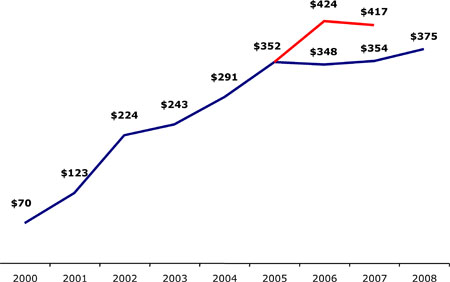| Posted: Jun 20, 2007 | |
Congressional pork bloats U.S. military nanotechnology spending |
|
| (Nanowerk Spotlight) The U.S. Department of Defense (DoD) has released its 2007 review of DoD nanotechnology programs. In 2007, estimated DoD nanotechnology expenditures will be $417m, about the same level as the year before. For the first time, however, the report lists the congressional additions to DoD's investment in nanotechnology. From 2005 to 2007, the Pentagon has requested about $350 million each year for its nanotechnology research. Congressional earmarks of $75.6 million in 2006 (actual) and $63 million in 2007 (estimate) have substantially increased this budget and given the Pentagon more money - and programs - than it actually asked for. | |
| The Pentagon report even states that "Congressional additions significantly complicate the assessment of current and proposed funding levels for the DoD investment in nanotechnology, since these Congressional appropriated programs commonly avoid the standard agency technical scrutiny. | |
| Furthermore, Congressional additions are often inconsistent with, or even in direct opposition to, the technical focus areas and directions of DoD agencies." Makes you almost feel sorry for the military... but it is yet another perfect example of how warped (sorry, can't use a stronger word here) the U.S. Congressional budget system has become. | |
|
|
|
 |
|
| Annual DoD investment in nanotechnology; 2007 and 2008 estimated. The blue line represents DoD requests. The red line shows actual funding including Congressional appropriations. The DoD does not show separate figures for Congressional appropriations prior to 2006 (Source data: DoD "Defense Nanotechnology Research and Development Programs" April 26, 2007) | |
| Unfortunately, the DoD report does not give any further details about the nature of the congressionally added extra programs. We have requested additional information and will keep you posted if and when we receive an answer. Meanwhile, let's look at the program update itself. | |
| The officially shown funding for numerous DoD nanotechnology research efforts (that are in the public domain) seems to plateau at around $350-400 million a year (not including the Congressional appropriations). The actual 2006 spending of $424 million was slightly less than last year's forecast of $436 (see our report "Military nanotechnology - how worried should we be?"). | |
| The 2007 budget includes a noteworthy increase of approximately $21 million to develop novel lithography instrumentation for affordable, high performance, low volume and application-specific integrated circuits. The report states that "this new facilities and instrumentation initiative will provide a cost effective manufacturing technology for low volume nanoelectromechanical systems (NEMS) and nanophotonic devices." It's nice to hear that "cost effective" is a term now used by the Pentagon but one could also speculate that the ability to closely control and guard certain facilities and processes might also have played a role in this investment. | |
| The military's fundamental research goals for its nanotechnology programs fall into three areas: | |
| 1) To discover new phenomena and processes to enable breakthrough advantages for war fighter and battle system capabilities; | |
| 2) To develop robust strategies for synthesis, characterization, and assembly of individual nanostructures; and | |
| 3) To explore applications of nanostructures for revolutionary catalysis, scavengers, taggants, sensors, thermoelectrics, thermionics, and photovoltaics. | |
| The DoD report concludes that, based on planned activities and the progress reported for last year, current funding levels are found to be adequate. The document also states that "substantial progress has been demonstrated towards each of the long term DoD program goals" and it recommends future investment focused on facilitating the transitioning of nanotechnology research results into products for defense technologies. This crucial step from lab to fab is mentioned as a significant barrier to the commercialization of nanomaterials and nanotechnology-based products. DoD recommends increased attention on nanomaterials "to realize strategies for robust incorporation and design of nanoscale phenomena into advanced materials for a broad spectrum of revolutionary target applications". | |
| As in the years before, the funding for risk-related research stays at a meager $1m. In this area, the report list as accomplishment that the DoD has established a Nanomaterials Working Group under the Emerging Contaminant Governance Board. The group's charter includes "addressing the need to develop internal procedures for assessing environmental, safety, and occupational health implications from DoD unique engineered nanomaterials, and for managing future potential environmental, safety and occupational health liabilities." Interestingly, when reading the full text, it becomes clear that "occupational health" refers to "health and safety of war fighters and defense product developers". Never mind those darn civilians. | |
| And we'll keep you posted on these Congressional additions... | |
 By
Michael
Berger
– Michael is author of three books by the Royal Society of Chemistry:
Nano-Society: Pushing the Boundaries of Technology,
Nanotechnology: The Future is Tiny, and
Nanoengineering: The Skills and Tools Making Technology Invisible
Copyright ©
Nanowerk LLC
By
Michael
Berger
– Michael is author of three books by the Royal Society of Chemistry:
Nano-Society: Pushing the Boundaries of Technology,
Nanotechnology: The Future is Tiny, and
Nanoengineering: The Skills and Tools Making Technology Invisible
Copyright ©
Nanowerk LLC
|
Become a Spotlight guest author! Join our large and growing group of guest contributors. Have you just published a scientific paper or have other exciting developments to share with the nanotechnology community? Here is how to publish on nanowerk.com.
